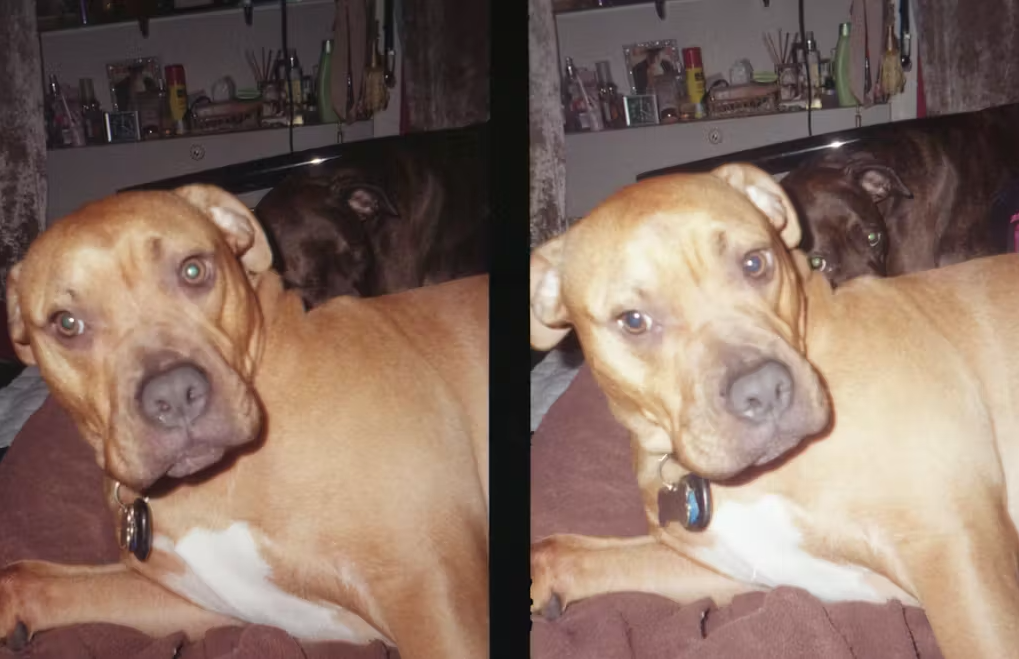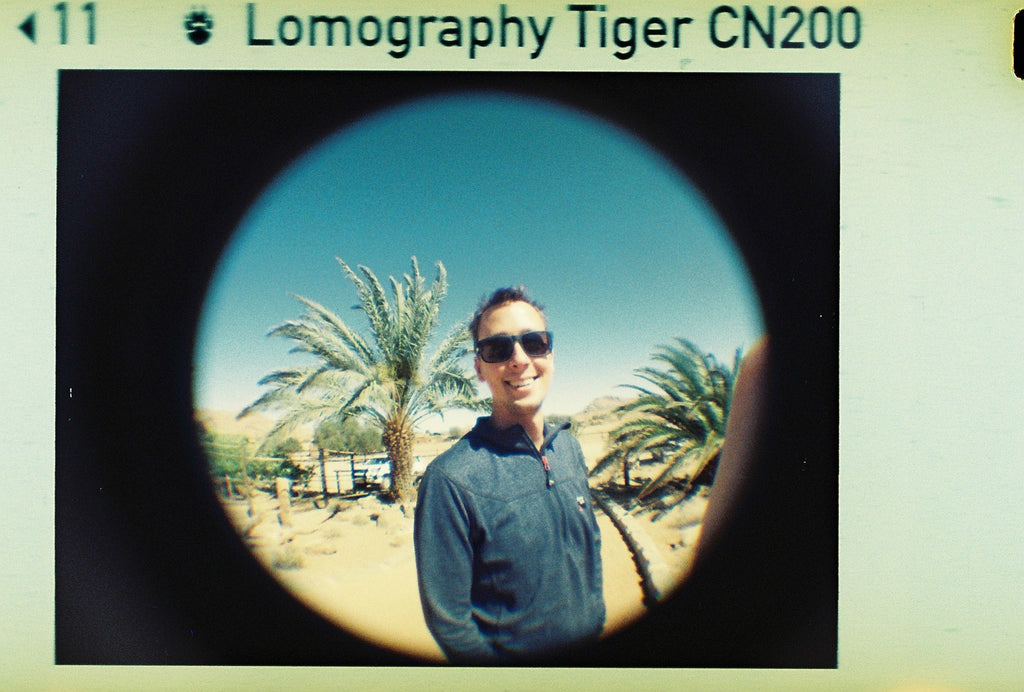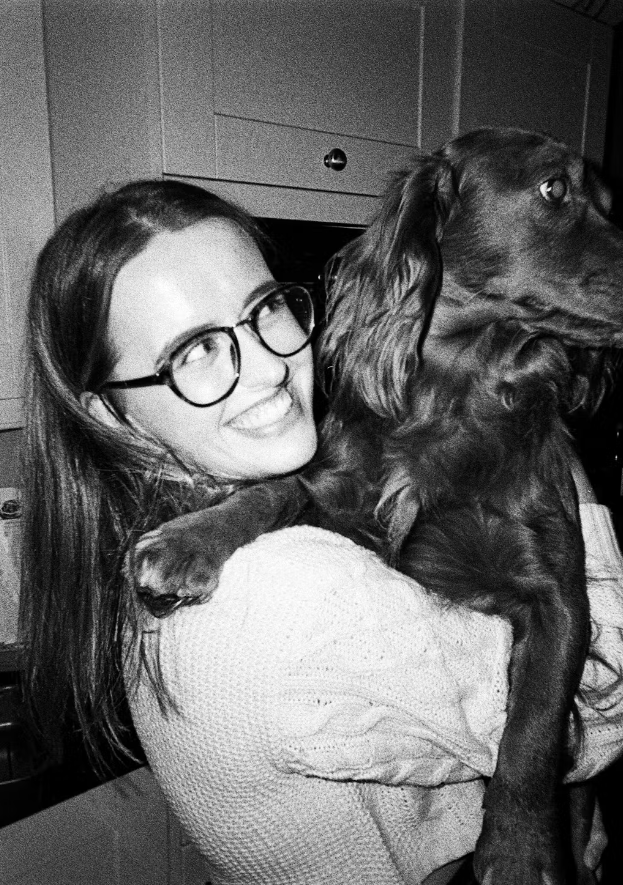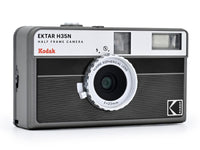Black Friday 2025 has landed at Analogue Wonderland, bringing some of our biggest film photography deals of the year - from discounted film and cameras to money-saving WonderLab processing offers, exclusive bundles, and festive specials available for a limited time only. Grab a great deal while stocks last!
Recent posts
Shop the article

Half-Frame vs. 110 Film: Compact Convenience
By Paul McKay
When you're picking a film format for a day out most people will select 35mm or 120. However I've noticed that film enthusiasts are increasingly exploring beyond the standard film formats to discover the delights of niche film types. Among these other options, half-frame and 110 film stand out as similar choices - both providing a relatively small image on the negative.
110 film was designed from the outset as a pocket format, known for its miniature size and ease of use. It has traditionally been pitched to photographers who value compactness and simplicity over image quality (although this isn't necessarily fair - we’ll get into the detail later!)
Meanwhile half-frame film photography uses 35mm film but only captures images on half a frame each time. This allows it to appropriate a standard format but fit double the number of exposures on each roll of film, making it a cost-effective and creative option.
This article will dive deep into the worlds of half-frame and 110 film photography, comparing their features, benefits, and the unique photographic opportunities they provide.
Understanding Half-Frame Film Photography
Half-frame film photography transforms the standard 35mm film roll from a 36-exposure cartridge into a whopping 72 frames. This is achieved by literally halving the size of the captured image on the negative (you can see more details on our half-frame explainer article), allowing photographers to make the most out of their film.

Two photos on one frame!
What is Half-Frame 35mm?
A half-frame camera captures images that are half the size of a standard 35mm frame. This results in an image size of 18x24mm, compared to the full frame’s 36x24mm. Originally designed as a budget-friendly option in the 1960s, half-frame cameras have seen a revival among contemporary photographers who appreciate the blend of economy and increased number of exposures. They can take fantastic photos - as seen in the first photos from the Pentax 17.
Benefits of Half-Frame Photography
One of the most compelling reasons to choose half-frame photography is its cost-effectiveness. Being able to squeeze twice as many images out of a single roll is a significant advantage for your budget. This makes half-frame cameras an excellent choice for extensive shooting sessions, travel photography, and experimental projects where you need to shoot a lot of images to get the final photo.
Half-frame cameras are also typically smaller and more lightweight than their full-frame counterparts. This portability makes them an excellent option for photographers who prefer to carry minimal gear while on the move.
This format is also perfect for creating diptychs - two images that are thematically connected and shown on a single frame of film.

I love this diptych: 'a phonebox in two parts' taken by Derek B.
Popular Half-Frame Cameras
Some popular models that have stood the test of time include the Olympus Pen series, particularly the Pen F, which offers a unique vertical orientation resulting in a portrait aspect for each shot, unlike most cameras that shoot in landscape mode. Another notable mention is the Canon Demi, known for its sharp lenses and reliable build quality.
More recently we’ve had a wonderful time with the Kodak Ektar H35 and its premium cousin the Kodak Ektar H35N. Customers often highlight their simplicity and user-friendliness, with one reviewer noting that the H35 is "perfect for beginners who want to jump into film photography without hassle." The camera's ability to produce "vibrant colours and high contrast" in images is particularly appreciated, which makes it ideal for capturing stunning landscapes and natural scenes.
There is also a VERY exciting BRAND NEW camera from Pentax, which launched on June 17th 2024; aptly named Pentax 17. We reported on its progress in our news blog here; the Pentax Film Project - It is a premium half-frame experience for modern film shooters - read our full review of the Pentax 17 here.🤩

So stylish and compact: the Kodak Ektar H35
Exploring 110 Film Photography
While half-frame cameras squeeze more pictures out of a 35mm roll, 110 film photography takes a different approach. Introduced by Kodak in 1972, 110 film is totally enclosed in a small, easy-to-load cartridge, making it perfect for quick snapshots and casual photography. This diminutive film format offers a simple, compact solution for everyday shooting.
What is 110 Film?
110 film is significantly smaller than 35mm film, measuring just 13x17mm per frame. It comes in a convenient cartridge that eliminates the need to manually thread film onto a spool, drastically reducing the chance of exposure to light and the accompanying risk of fogging. This ease of use made the 110 format incredibly popular among amateur photographers and remains a charming choice for those looking for a no-fuss shooting experience.

A 110 film cartridge next to its box
Advantages of Using 110 Film
The primary advantage of 110 film is its compactness. Cameras designed for 110 film are often small enough to fit in a pocket, making them ideal travel companions. I often pop one in my jeans for trips - theme parks - that kind of day. Additionally, the simplicity of loading and using 110 film cameras makes them an excellent choice for beginners or for those who prioritise convenience and portability over technical control.
The film's diminutive size also lends a distinct, nostalgic graininess to images. This can be particularly appealing to those who cherish a vintage aesthetic in their photographs.

Notable 110 Cameras
The Pentax Auto 110, inspired by SLR designs, offered interchangeable lenses, a rarity in the realm of 110 cameras and brought a level of versatility that was unheard of in such compact devices. Another popular choice was the Minolta Pocket Autopak 430E, which provided automatic exposure settings and a built-in flash, features that enhanced its appeal as a point-and-shoot camera for everyday use. In the 80s and 90s there was a trend for including very basic 110 cameras - essentially just a lens and button with the ability to slot in front of a 110 cartridge - in cereal boxes, brand giveaways, and other promotional activity.
Lomography resurrected the 110 film format in the 2000s, and they now manufacture a wonderful range of 110 films and cameras. I’m personally excited about the Lomomatic which promises to be a modern version of a Halina!
I've also shot quite a lot with the Baby Fisheye camera over the years. The unique super-wide lens matches well with the small film format to create distinctive images.

My baby daughter rocking the Baby Fisheye 🥰
Comparison of Image Quality and Usability
When choosing between half-frame and 110 film, it’s essential to consider the quality of images each format can produce and how user-friendly they are. While both offer unique advantages, their practical applications can be quite different depending on what you're looking to achieve with your photography.
Image Quality
Half-frame 35mm film uses the same type of film stock as standard 35mm cameras, which means it retains the high-quality characteristics of traditional film, such as fine grain and wide dynamic range. However, because the image area is half that of a full frame, enlargements from half-frame negatives can appear grainier and less sharp than those from full-frame negatives. This is something to consider if large prints are your end goal.
You also have the opportunity to shoot on premium film stocks like Kodak Portra or Ilford Delta 3200, which will often compensate for the smaller image size.

Ilford HP5 35mm film, shot in half frame by @_Eviedoesit "how decent is it that you come away with 72 pictures! Why didn't I discover half frame cameras before?"
110 film, on the other hand, has a much smaller negative size, which inherently limits the resolution and detail that can be captured. While this can be seen as a drawback for high-resolution needs, the grainy and distinctly 'retro' look of 110 film prints can be highly appealing for those seeking a vintage or stylised aesthetic. There is also a much smaller range of films available for 110 - you are limited to Lomography’s films or expired emulsions - and they do not have the same quality as the most premium 35mm films.
The smaller negative size also means that 110 film is more forgiving with depth of field, allowing more of the image to stay in focus, which can be advantageous for quick snapshots.
Usability
In terms of usability, half-frame cameras are often praised for their compactness and efficiency, allowing photographers to take double the number of photos per roll of film. They attract those who enjoy shooting a lot without the frequent need to change rolls, ideal for travel and street photography where opportunities pass quickly.
110 cameras are even more compact and designed for ease of use, often fully automated with fixed focus lenses and simple exposure controls. This makes them perfect for casual photography, quick family snapshots, or for those who do not wish to fuss over settings. They are the epitome of point-and-shoot convenience.
Both formats offer unique ways to enjoy photography. Half-frame is suitable for those who still want the detail and versatility of 35mm film but with more frames per roll, while 110 film appeals to those looking for the simplest, most portable way to capture moments on film.

110 format, fisheye lens, and light leaks. Dreamy
Processing, Developing, and Scanning: Half-Frame vs. 110 Film
The world of film processing is as varied as the cameras and films themselves, and the peculiarities of half-frame and 110 film present unique challenges and considerations in the developing and scanning stages.
Processing and Developing
Half-frame 35mm film is processed in the same way as standard 35mm film, which means it can be developed at any photo lab that processes 35mm film. However, because the images are smaller, some special attention is needed during the scanning process to ensure that the entire image is captured accurately and that the resolution is optimised for the smaller negative size.
110 film requires specific cartridges for processing and not all labs will handle this format due to its less common nature and the specialised equipment needed. If you’re shooting 110 film, it’s a good idea to check with local labs or look for services online that specifically mention they can process and scan 110 film. Given its size, 110 film can be more susceptible to handling marks and scratches, which makes careful processing even more critical.

Half-frame 35mm at the top; full-frame 35mm in the middle and 110 film at the bottom - you can see the difference in absolute image size, sprocket spacing, and photo orientation of half-frame vs 110
Scanning
Scanning half-frame negatives often requires manually adjusting the film holder or scanner settings because standard settings are designed for full-frame 35mm images. This ensures that the scanner correctly interprets the smaller images and doesn’t accidentally cut them off or merge them into each other.
For 110 film, scanning can be a bit more challenging due to the very small negative size. High-resolution scans are necessary to make the most of the available image quality. Specialised film holders or scanners that accommodate the smaller film format are required to achieve the best results. It's worth noting that some detail may be lost during scanning due to the small size and grain structure of the film.
Tips for Best Results
- Check Compatibility: Always ensure that your chosen lab can handle and is experienced with either half-frame or 110 film.
- Request High-Resolution Scans: To capture as much detail as possible, especially important for enlargements.
- Protect Your Film: Both formats are delicate; handle with care during loading and unloading to prevent scratches or other damage.
Handling and scanning these film formats may require extra care and possibly a bit more expense, but the unique results and satisfaction of shooting with these less-common formats can be well worth the effort.
Which Is Best? Choosing Between Half-Frame and 110 Film
Choosing the right film format is not just about the type of images you want to capture, but also how you want to capture them. Here’s a guide to help you decide whether half-frame or 110 film is the right choice for your photographic needs and style.
When to Choose Half-Frame Film
Half-frame film is ideal for photographers who:
- Want to maximise the number of exposures per roll, perfect for long trips or events where frequent film changes are impractical.
- Appreciate the ability to create diptychs or themed photo sets within a single roll due to the increased number of exposures.
- Enjoy having a bit more control over their images while still retaining the distinct look and feel of film photography.
- Are okay with a slightly lower resolution in their final prints but value the cost-effectiveness of the format.
Popular with street photographers and those documenting their travels, half-frame cameras allow for a unique blend of quantity and quality, capturing many moments without the worry of running out of film.

I really love the composition and colours from @flowermoodforyou 🫶🏼
When to Choose 110 Film
110 film might be the better choice for photographers who:
- Prioritise compactness and ease of use, with cameras that are often small enough to fit in a pocket.
- Seek the simplicity of point-and-shoot options for spontaneous photography without fussing over settings.
- Are new to film photography or prefer a hassle-free photographic experience, especially suitable for young photographers or beginners.
- Love the nostalgic, soft, and distinctly vintage aesthetic that the small film format naturally provides.
110 film is excellent for casual, everyday photography, family gatherings, and for those who wish to capture life's moments with minimal intrusion from the gear they carry.

Taken on Lomography Metropolis 110 film (c) Paul McKay
Conclusion
Whether you lean towards the innovative, cost-efficient half-frame format or the ultra-compact, straightforward 110 film, both provide unique avenues to explore the rich world of film photography. Each has its charm and functional appeal, catering to different styles and scenarios in the film photography landscape.
Experimentation is key in discovering your preference, and with both formats, you're bound to enjoy the process as much as the results. So why not try both and see which film type resonates more with your creative vision?
Have you tried shooting with half-frame or 110 film before? What was your experience like, and which do you prefer for your photography adventures?
Ready to dive in?
Keep Reading
View all
Christmas 2025: Shipping & Opening Hours
Christmas 2025 is fast approaching! To make sure your analogue goodies arrive in time, take note of our last shipping dates, plus opening and operating hours over the festive season. We've got everything you need to gift the magic of film photography this Christmas!

Film Photography Christmas Gift Guide 2025: Analogue Wonderland
Capture the magic of Christmas with film - no filters needed. Our 2025 Film Photography Christmas Gift Guide 2025 is packed with thoughtful presents for every type of shooter, from curious beginners to seasoned photographers. Discover film stocks, cameras, and creative accessories that will make this festive season truly memorable.
Subscribe to our newsletter 💌
Sign up for our newsletter to stay up to date on film photography news, sales and events:
Free Tracked Shipping
On all UK orders over £50
Passion For Film
An unbeatable range and an on-site lab
Our Customers Trust Us
Thousands of independent 5* reviews
All Deliveries are Carbon Neutral
Independently audited and verified by Planet
- Opens in a new window.








9 Comments -
Peter Cordiner • -
bill sherren • -
Mark • -
Neil •
← 1 2
I love using an old Halina telewide 110 I bought to experiment with this format, the results are generally pleasing and the pocket sized point and shoot simplicity of the camera is brilliant. I quite enjoy the grainy vintage feel to the prints and the camera never fails to attract interested comments and conversation from other folk who thought 110 was no longer available.
The 24 exposure 110 film does make it a higher cost option compared to full and half frame 35mm 36/72 exposure film and some may not like the grain but its great fun and a different take on photography today.
Loved using half frame cameras as a child and adult. Started with an Olympus Pen EE and later inherited my Dads Pen F SLR camera which took great shots. All my shooting was on slide film and with a suitable projection lens gave great results on a projection screen.
An interesting article but I don’t really understand the comparison. Half frame with a decent lens (I.e almost any Olympus Pen) provides 72 shots (at least) with good quality for such a small neg with an almost endless choice of film stock and the ability to be creative with diptych and Triptychs, whereas 110 provides 24 shots of poor quality with limited film stock choice. They really are chalk and cheese formats and it is difficult to justify 110 compared to half frame.
I still have my 110 camera from when I was a child. Despite having much “better” cameras to choose from, this gets quite a lot of use just because I live the simplicity.
I once respooled Ektar into an old cartridge with great results.